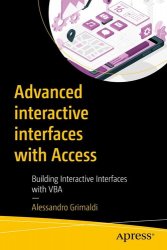 Название: Advanced interactive interfaces with Access: Building Interactive Interfaces with VBA Название: Advanced interactive interfaces with Access: Building Interactive Interfaces with VBA
Автор: Alessandro Grimaldi
Издательство: Apress
Год: 2024
Страниц: 287
Язык: английский
Формат: pdf (true), epub
Размер: 10.1 MB
Explore and learn advanced techniques for working with graphical, interactive interfaces that can be built in Access.
This book starts with best practices and tips to write code using VBA, and covers how to implement them in a real-world scenario. You will learn how to create and use VBA classes. An introduction to the binary code and the "bit vector" technique is discussed, followed by the implementation of a drag-and-drop engine. You also will learn how to design a timeline, and make it scrollable.
The importance of mastering classes should be obvious in any OOP programming language. Knowing how to build and use them is crucial because it enables you to create organized, reusable, and efficient code. Classes provide a blueprint for creating objects, promoting code modularity and encapsulation. This empowers you to build complex systems and enhance code readability and maintainability while facilitating teamwork and code collaboration. Now, what exactly are OOP languages, and why is VBA not one of them? The OOP (object-oriented programming) is a programming paradigm that utilizes the concept of “objects” to structure and design computer programs. In this context, a class is a template defining the attributes (data) and behaviors (methods/functions) shared by objects of that class, and an object is an instance of that template.
Languages like Java, C++, Python, and C# are examples of popular OOP languages, as they fully embrace the principles and concepts of object-oriented programming. What’s wrong with VBA, then? Well, VBA is often considered a “light” or “limited” OOP language, for it does support some OOP features, but it lacks some advanced capabilities found in more modern and fully-fledged OOP languages. Due to these limitations (and to a diffused, generalized, absolutely unjustified aversion to this language), VBA is often seen as a procedural language with some OOP features rather than a fully-fledged OOP language. The good news is that we can happily live with these limitations (and sometimes exploit them, as we’ll see later), and classes remain a powerful tool to create our complex applications. I assume that if you are reading this book, you already know something about classes. Maybe you’re not an expert, but you should know how to work with them (at least in theory).
What You Will Learn:
Write readable, easy-to-maintain code
Add a drag-and-drop engine to an Access application
Apply variations to the drag-and-drop technique to create different graphical effects
Embed a scrollable timeline in an Access application, on which objects can be dynamically placed
Any source code or other supplementary material referenced by the author in this book is available to readers on GitHub.
Who This Book Is For:
VBA developers.
Contents:
1. Writing Code: Good Practices and Tips
2. VBA Classes
3. The Presence Vector Technique
4. Advanced Interfaces: Drag and Drop
5. Advanced Interfaces: Scrollable Timeline
6. Outro
Скачать Advanced interactive interfaces with Access: Building Interactive Interfaces with VBA
|